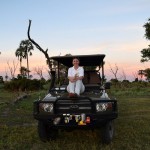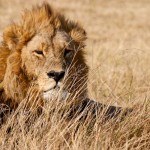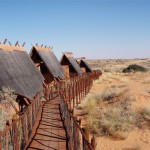Dianne Tipping-Woods takes a close up look at some of the best Botswana Safaris as she reviews three luxury safari camps.
We had landed amid a miracle: late rain falling over Nxai Pan in northeastern Botswana. The parched terrain around the dried-up salt pan sighed with relief as the shower washed the chalky dust off the short shrubs. I was on the safari-of-a-lifetime: a fly-in trip starting in the timeless Nxai Pan National Park landscape and ending in Kasane, a small town near where Botswana, Namibia, Zimbabwe, and Zambia meet. In between, I explored the Okavango Delta’s famed waterways and the Kwando’s wilderness, ferried vast distances in record time by small planes from Moremi Air.
Nxai Pan

After leaving Maun in a six-seater Cessna, I alternated between looking out for baobabs and elephants below and drifts of sun-lit rain on the horizon. We landed on a dirt runway near the ancient, dusty pan the national park is named after. The rain shower was quick and light, but the air was heavy with petrichor. Wild sage shone silver grey among the ochre grass. In the rainy season between December and April, nutritious grasses sprout around the pan and attract large herds of zebra from Namibia’s Zambezi Region—a journey of about 250 kilometres. This 500 km round trip is even longer than the Serengeti wildebeest migration.
It was late April, and most zebras had left, but we spotted three on the drive from the airstrip to Nxai Pan Camp. We also saw a herd of elephants, a scorpion excavating its burrow, and a shy kudu antelope with massive spiral horns. “We get so much variety here, including species better adapted to dry conditions like gemsbok, springbok, and aardvark,” explained guide JR Maphane. The camp is one of the few inside the national park. When we arrived for high tea, elephants were at the nearby waterhole. “This time of year, they’re always here,” said Maphane.


Wildlife in Botswana, particularly elephants, move freely between national parks, private concessions, and communal land, creating terrific game-viewing opportunities. An aerial survey in August 2022 by WWF and partners counted 132,000 elephants in Botswana, more than half of the roughly 227,000 in the transboundary Kavango Zambezi Transfrontier Area (KAZA) area. The elephants need to drink up to 160 litres a day, and waterholes like the one by Nxai Pan Camp are a lifeline.
Later, Maphane drove towards the herd. We lingered in the golden light as they drank, splashed, gurgled, and eventually headed into the darkness. Around the campfire that night, two large bulls ambled past within meters of us. Were they the ones trumpeting their discontent later in the early morning hours, disturbed by the pride of lions I heard roaring from inside my suite?
4 Rivers

The vivid waterways of the Okavango Delta – a UNESCO World Heritage site just a 50-minute flight from Nxai Pan – contrasted sharply with the drylands. The Delta’s lush, life-sustaining network of channels and marshlands is created as the Okavango River flows into the desert instead of the sea. The annual flooding coincides with Botswana’s dry season, making it a veritable winter oasis, although game viewing is generally good year-round.
The flood was coming in, and seeing the green network of channels, streams, and pathways from the air was breathtaking. We’d spotted elephants, hippos, crocodiles, and pelicans during the flight before our official Delta safari began. Soon, pilot Laone Gabasiane radioed, “Air traffic inbound Kawara,” lining the plane up with the runway near 4 Rivers Camp. A game drive vehicle was parked to chase any animals away as we skimmed over the treetops to land.

4 Rivers opened in the 150,000-plus hectare Kwara Private Concession in 2023. The solar-powered camp has nine luxury tents among giant leadwood, jackalberries, and sausage trees. It shares its spot on the edge of a permanent lagoon on the Tsum Tsum Channel with a resident pod of hippos, many waterbirds, and whatever animals come to drink. Elevated boardwalks connect the tents, with pathways left for hippos and elephants.
That evening, we drove through golden grasslands and found lions hunting lechwe antelopes, dancing zebras, and a majestic wattled crane. The next morning, we took to the water in a traditional mokoro (like a canoe). Hundreds of waterlilies had just opened, and tiny silver fish darted in the shallows. Painted reed frogs clung to the papyrus, and we looked out for ever-present hippos. Along with elephants, they create many pathways through the dense vegetation. “We call this area paradise, and it is, for elephants and everything else,” said guide Olebogeng Alco Mbwe.

That afternoon, on a bush walk, we admired a baboon spider’s nest and an elephant skull (it had died naturally) and followed hyena tracks through a grove of apple leaf and giant mopane trees filled with squealing Meyer’s parrots. All the tallest trees grow out of the ubiquitous termite mounds. The industrious insects are a vital keystone species in this ecosystem. “Many of the Delta’s islands started out as termite mounds, too. It’s all connected,” said Mbwe. Before we left, we’d seen more lions (a mating pair), a leopard and her cub, a large herd of buffalo, more elephants than we could count, and a range of other wildlife, including a rare serval.
Lagoon Camp

Our second-to-last destination was Lagoon Camp on the Kwando River, another short flight away. We shared the airways with vultures and spotted more herds of elephants near waterholes and pans as the ground became drier. Lagoon Camp is an important wildlife dispersal area and a haven for elephants, especially in the dry season from May to October. Elephants regularly move through the camp too, picking up ripe marulas (wild fruit) en route to the river. Lions, zebras, and wild dogs also move through this landscape, connecting core wildlife areas in Botswana and neighbouring countries, allowing animals to roam in search of food, mates, and new territories.

Lagoon Camp is more rustic than Nxai Pan and 4 Rivers camps but charming and intimate. Its central deck spreads out from a giant mangosteen tree where I watched baboons playing. It offers uninterrupted views of hippos and other wildlife along the riverbanks. African jacanas were hopping from lily pad to lily pad, spur-winged geese, three-banded plovers, and black-winged stilts along the riverside. When we returned from our first game drive (where we spent exceptional time with a large, relaxed male leopard), there were fresh lion tracks in the parking area. I was grateful for the mandatory ranger escort back to my room that night.


One last flight with Mack Air (another charter service), and I was on the Chobe River for a sunset cruise just upstream from the tourism hub of Kasane. Guide Neo Samunzala manoeuvred us downstream, confidently anticipating where the herd of elephants we watched would swim and wade across the river using their trunks as snorkels before they emerged black and dripping on the opposite shore. A large female used her trunk to gently usher a youngster up the bank. Then, they all disappeared into the trees.
All images (C) Kwando Safaris
Tell Me More About Best Botswana Safaris
When it comes to best Botswana safaris,Kwando Safaris operates luxury safari camps across Botswana, focusing on intimate experiences in exclusive locations, expert guiding, and flexible activities tailored to guests’ preferences.
NXAI PAN CAMP
The camp faces east over the open grasslands of the pans. Its airy, minimalist style is a tribute to the landscape’s stark beauty. Guests can visit the famous Baines’ Baobabs (immortalized by artist and adventurer Thomas Baines in 1862). They also offer a San bushcraft walk to learn about their deep cultural ties to the land.
4 RIVERS CAMP
This camp offers guests exclusive use of the western side of the renowned Kwara Private Concession for game drives, guided bushwalks and mokoro trips. It’s also a new camp (opened in 2023), and the quality of the tented accommodation is exceptional.
LAGOON CAMP
The old-school, intimate feel of this camp sets it apart. Between March and December, it offers guests additional activities like river cruises and fishing, along with productive game drives and walks in the mornings and afternoons.
COSTS
Prices vary by season and camp selection, ranging from $875 to $1,635 per person per night. Rates are quoted on a twin-sharing basis and include accommodation meals and beverages, game-viewing activities (twice daily), and laundry. They exclude transfers into camp on scheduled light-aircraft flights.
GETTING THERE
The easiest way to reach Kwando’s properties is by light aircraft transfer from Maun with their sister company, Moremi Air, or another charter company. Driving can take 10 times as long over rugged, hard-to-navigate roads.
For more information on these best Botswana safaris and travelling to Botswana and the KAZA region, visit www.africaseden.travel.







Hola
Le escribo porque estoy buscando para ponerme en contacto con la guía Neo Samunzala de chobe. Hemos perdido su número y estamos deseando volver a conectar con ella. Fue nuestra magnífica guía hace unos años y hemos mantenido el contacto hasta el año pasado, ero hemos perdido su número. Haciendo una búsqueda por Internet he visto que la nombran en su artículo y estaríamos muy agradecidos que si tienen contacto con ella o donde está trabajando ahora, pudieran darnos su contacto.
Soy mayte Santos, de España, y mi correo es maytesa@hotmail.com.
Disculpen de antemano las molestias y nuestro agradecimiento .